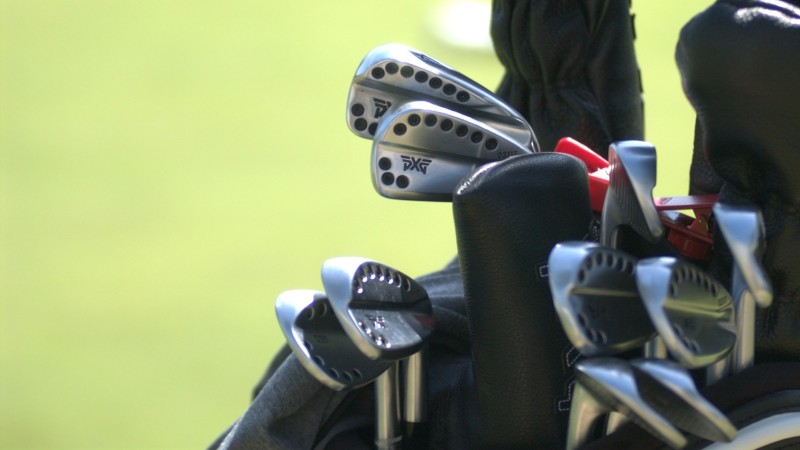If you are just getting started with the game of golf or a high handicapper that has been struggling to improve, your iron play is probably holding you back. Hitting a 7-iron off an uneven lie in the fairway or trying to catch a wedge solid from the rough is challenging. In order to shoot lower scores, you need to hit more greens, but that is easier said than done.
The biggest mistake you can make is getting too technical – the answer is not complicated swing thoughts. We will not be discussing your swing plane or how much you should be shallowing out the club.
Our goal is to help you hit more consistent approach shots and keep it nice and simple.
In this post, we share five things for you to try, that you can easily tinker with the next time you visit the driving range or play 9 holes.
You may also like:
- Breaking 80 Golf Rangefinder Review
- How To Hit A Driver Straight Every Time
- How Much Does It Cost To Put A Golf Simulator In Your House?
Short & Sweet
Your iron swing does not need to wrap around your neck – in fact, you can have great success with a short backswing. If you are struggling to make consistent contact with your irons, simplification is the key.
The next time you go to the driving range, try hitting some 7-irons making a half swing. Do you hit it straighter? Do you hit it more solid? Now you can try to extend your swing a little bit but keep it tight. It is much easier to keep a short swing connected. Try to play 9 holes where you take a half swing with every iron shot – if necessary, hit one extra club. You might just shoot your lowest score yet.

Press Forward
A common mistake by amateur golfers is poor hand position in relation to the ball. You never want your hands to be behind or even with the ball – this will cause you to hit scoops, skulls, and blades. Instead, when you setup to an iron shot, press your hands forward.
This might feel strange at first but stick with it. The forward press will start your swing in a great impact position, so just take the club back and return it to the same spot. This will naturally create a downward motion towards the ball, and we will talk about the importance of that shortly.
The shorter the club, the more you should press forward. Really get those hands in front of the ball when hitting a wedge and do it slightly less if you are hitting a long iron.
Down for Up
It may not be intuitive, but if you want to hit high and soft iron shots, you need to hit down on the ball. Many players that struggle in the game of golf try to help the ball in to the air by hitting up on it – the only time this is a good idea is off the tee with your driver.
In order to hit quality iron shots, you need swing down through the ball. You need to swing down if you want to hit the ball up. We would not recommend that you really try to swing down, because this will most likely cause fat shots. Instead, make a good swing and let the loft on the club do the work. Trust that the ball will go in the air and you do not have to help it.

Low & Slow
Where do players typically mess up their swing? Sadly, it is right at the beginning. It is quite possible that you get the club in a bad position in the first few inches of your backswing. Once you are in this position, it is hard to correct and hit a solid shot.
A nice, simple swing thought is “low & slow” and we are referring to how you start your swing. Take the club back low to the ground and do so slowly. When you practice, you can even try this in super slow motion to get the feel.
Where do you want the most speed in your swing? The correct answer is near impact, but many golfers actually have more speed during their backswing or during their transition “at the top”. Starting your swing low & slow will help with your rhythm and prevent you from getting in a bad position from the start.
Play in the Dirt / Investigate Your Divots
Unlike your driver or fairway wood, irons shots require you to hit the ground. You actually get most of you power in an iron shot from trapping the ball against the ground, so it is critical that you make a divot when hitting an approach shot. Most of the time, you want to hit a larger divot with your shorter clubs.
You can learn a lot from your divots. After every iron shot, take a few seconds to check your divot – it is immediate feedback on your swing. First, check to see which way it points, if it points to the right, you made a draw swing and if it points to the left, you made a slice swing. Second, how is the depth? Did you hit the shot fat, thin, or perfect? Third, where is the divot? The perfect divot will be in front of the ball. If your divot is too far back, you will continue to hit fat shots.

Final thoughts on hitting better irons
We know it is hard to receive swing tips via an article, so it is important you try these ideas on the driving range. A few will make perfect sense and help your game, while others may not work at all for you. That is ok – everyone’s golf swing is different. Finding one or two tips that you can use on the course is the goal.
Improving in golf is a marathon, not a sprint. Look for small improvements in your iron game and celebrate them. Stay positive and before you know it, you will be hitting 10+ greens per round, making a few birdies, and shooting lower scores than you ever thought possible.

